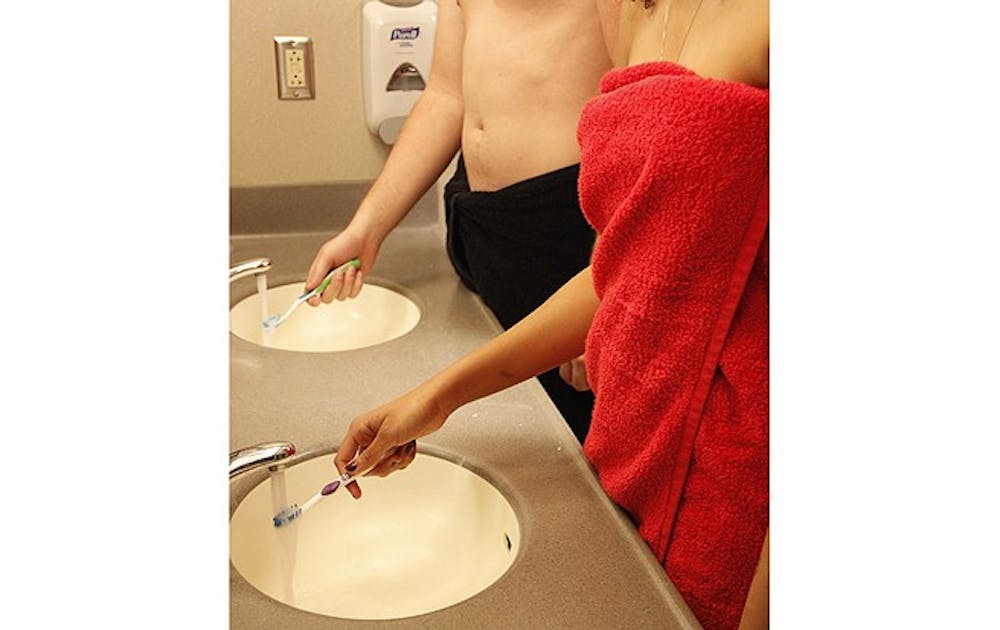Students’ reactions to the expansion of gender-neutral bathrooms on campus have been, on the whole, neutral.
In the Fall, the University designated five gender-neutral, unaffiliated houses on West and Central Campuses for the upcoming academic year—Kilgo MN, Kilgo OP, Upper Few HH, 1914 Lewis and the south face of 2015 Yearby. The three houses on West will incorporate a gender-neutral bathroom in addition to at least two single-gender bathrooms available, said sophomore Jacob Zionce, DSG vice president of residential life. Currently, gender-neutral housing consists of one house on Central Campus.
“The idea of gender neutrality was that there would need to be three bathrooms on each floor in order for each house to qualify—a male bathroom, a female bathroom and a gender-neutral bathroom,” Zionce said. “The main focus was to make sure everyone is comfortable in their living situation.”
Interviews with several students in houses designated for gender neutrality reflected a lack of concern for the addition of gender-neutral bathrooms in their sections, given that single-sex bathrooms would still be available.
“I don’t mind having a bathroom that is co-ed, as long as I will still have access to a girls-only one,” said sophomore Elizabeth Sharkey, a resident of Upper Few HH.
A half dozen other students in Sharkey’s section also noted that the installation of a co-ed bathroom would be acceptable, but only in conjunction with a single-sex bathroom.
Another important concept within the institution’s model of gender neutrality was a student’s right of return to their current house in the following academic year, said Joe Gonzalez, dean for residential life. If a student feels uncomfortable with gender-neutrality, they would be able to return to an adjacent house.
“There are two basic ideas that are working opposite each other at this point,” Zionce noted. “There’s the one idea of gender neutrality, a concept that is truly transcending what has been in place here at Duke... and on the other hand, the idea of maintaining house autonomy and making sure each house is heard.”
The way in which HDRL balances the two ideas is crucial, he said. As a result, members of DSG, Duke Students for Gender-Neutrality and HDRL will be holding meetings with each of the five designated houses as a means of facilitating a dialogue about the changes, Zionce said.
The discussions at these meetings will likely not constitute grounds for a change to the gender-neutral model, Gonzalez said. Only when a particular house is steadfastly opposed to its assignment of gender-neutrality will different avenues be considered, likely including a house vote, Zionce added.
Both Gonzalez and Zionce said they doubt that there will be overwhelming dissent from the expansion of gender neutral housing, given that the support for gender neutrality has been consistently strong.
But sophomore Ruslan Ardashev, house council president of upper Few HH, said he hopes that the house will be able to vote.
“I’d rather let the house choose whether or not it wants to become gender-neutral,” Ardashev said. “I was told that it could potentially come to a vote and I want everyone to feel comfortable.”
He added that even though students not content with the new house policy would be granted right of return to an adjacent house, not everyone would be comfortable with such accommodations.
Extending the policy of gender-neutrality to bathrooms is a by-product of increasing the gender-neutral housing options, Gonzalez noted.
“Students prefer and deserve to have the [gender-neutral] option on both campuses,” Gonzalez said. “So, to me, that was the most important reason for expanding [gender-neutrality].”
Selective houses may also opt to become gender-neutral, if their house is able to accommodate both single-sex and co-ed bathrooms, Zionce said, adding that as of yet, no group has approached HDRL about this option.
DSG President Alex Swain, a senior, noted that the addition of gender-neutral bathrooms is a significant step in making the University accessible to all students.
“The availability of gender-neutral bathrooms will open up new avenues for gender-queer students to feel comfortable on campus,” Swain said. “For the rest of the community, it is important to respect their needs and wants.”
With the expansion of the new gender-neutral houses, Duke will follow in the footsteps of many peer institutions, including Brown University, Tufts University, the University of Michigan and the University of Pennsylvania, which provide gender neutral housing in a variety of housing options.
Although DSG looked at the policies in place at other institutions, DSG and DSGN created a model that was a “uniquely Duke venture,” Zionce said.
“In the end, we had to find a model that reflected the strengths of our selective house system, [selective living groups], sororities and fraternities—one that we could implement so that [students] in various situations could be happy and comfortable,” he added.
Get The Chronicle straight to your inbox
Signup for our weekly newsletter. Cancel at any time.

